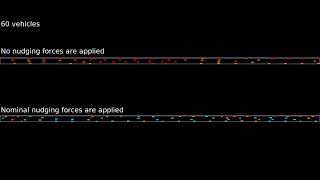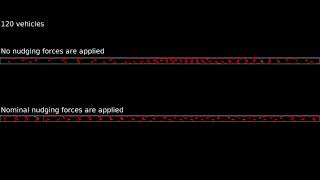Video Playlist 1: Lane-free artificial-fluid concept for vehicular traffic
The videos included in this playlist are excerpts from simulations described in the paper titled "Lane-free artificial-fluid concept for vehicular traffic", albeit re-run for a ring-road that is shorter in length (0.5 km, same width) to enable full visibility on a screen. Each video consists of two parts: The first part starts with the initial state at time 0 and lasts for 600 time-periods; while the second part displays the last 600 time-periods of the simulation and reflects the resulted quasi-stationary traffic situation. Visual has been sped-up by a factor of 4. Vehicle colour signifies deviation from desired speed: Dark red corresponds to a significant deficit of speed; colder colours, such as bright yellow and light green, correspond to a 15-10% deficit w.r.t. desired speed; blue colour corresponds to being less than 10% below the desired speed. Note that, in scenarios with nudging, it is possible to exceed the desired speed, in which case vehicle colour tends to darker shades of blue.
60 Vehicles
No nudging forces are applied: No nudging is in effect with 60 vehicles over a ring-road of 0.5 km. As visible in the first part of the movie, vehicles are initially placed on the road surface in a quasi-uniform manner and eventually seem to self-organize into “waves” of triplets. In the second part of the video, flow has stabilized to about 9,900 veh/h. Vehicles on the right-hand side of the road have attained a speed that is closer to their desired speed, as signified by colour. This is expected, as, initially, vehicles with lower, and thus more easily attainable, desired speeds were placed on the right-hand side of the road. An occasional and irregular pattern of quartets seems to emerge, hinting to a more effective utilization of road-width.
Nominal nudging forces are applied: Nominal level of nudging is in effect with 60 vehicles over a ring-road of 0.5 km. In contrast to the no-nudging case, the majority of vehicles are now attaining their desired speed. In contrast to the no-nudging case, no regular pattern of vehicle triplets is emerging. Instead, lateral movement, assimilating overtaking maneuvers, is observed. In the second part of the movie, flow has stabilized at about 10,500 veh/h. No significant differences w.r.t. the initial period of the simulation are observed; this indicates a very short transition period from the initial standstill to the quasi-stationary flow conditions.

120 Vehicles
No nudging forces are applied: No nudging is in effect with 120 vehicles over a ring-road of 0.5 km. As in the case with 60 vehicles, a self-organization into triplets (and sometimes quartets) emerges from the initial uniform placement of vehicles on the ring-road. Frequent emergence (and dissolution) of short congestion zones and related backward-moving shockwaves is observed. At the second part, average flow stabilizes at about 9,200 veh/h. As expected, vehicles on the right-hand side of the road are closer to their desired speeds. Moreover, a self-organization into lateral vehicle quartets emerges in this congested scenario. Forming of a backwards moving shock wave is observed.
Nominal forces are applied: Nominal level of nudging is in effect with 120 vehicles over a ring-road of 0.5 km. In contrast to the no-nudging case, a pattern of lateral quartets seems to emerge shortly after the initial state. With slower vehicles making way for faster upstream vehicles, movements assimilating overtaking maneuvers are observed. In the second part of the movie, flow has stabilized to the very high level of about 15,300 veh/h. No shock waves are visible. No significant differences are observed w.r.t. the first period of the simulation, which indicates a very short transition period from the initial standstill to the quasi-stationary flow conditions.

